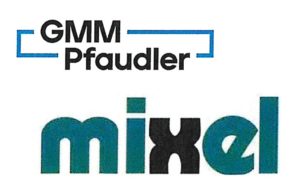Np = power number
It is an adimensional number that depends on the propeller type. It varies according to the Reynolds' number and to surroundings (position in the tank, propeller diameter/tank diameter...).
Np is invariable in turbulent regime (Re > 10 000)
Nq = pumping number
It is an adimensional number that depends on the propeller type and stays constant in turbulent regime.
The absorbed power depends on the Np of the propeller, on the product voluminal mass, on the rotation speed and on the propeller diameter.
P = Np r N³D5
Qp = pumping flow
It is the liquid flow produced in the section of the agitation propeller. It depends on the Nq, on the rotation speed and on the propeller diameter.
Qp = NqND3
The circulation flow Qc can be calculated from the pumping flow.
Circulation flow Qc = pumping flow Qp carried away flow.
1,5 Qp < Qc < 2 Qp
Vf = flow velocity
It is the medium liquid velocity in the propeller section.
It's calculated only for axial flow impellers (TT, TTP... propellers) and for radial flow ones (Rushton turbine).
Vp = peripheral speed
It is the linear velocity of the propeller at the end of the blade. It is calculated for every kind of impeller. (axial, radial or tangential flow).
Vp = p DN
Heat exchange = calculation of hi transfer coefficient on the side of the reactive fluid.
FORMULAS
ρ = VOLUMIC MASS (kg/m³) μ = VISCOSITY (Pa.s) Cp = SPECIFIC HEAT (Kcal/Kg) K = HEAT CONDUCTIVITY OF THE PRODUCT (Kcal/s.m.°C) D = DIAMETER OF IMPELLER (m) T = DIAMETER OF TANK (m) N = ROTATION SPEED (tr/s) Re = REYNOLDS' NUMBER Adimensional number used to determinate the flow regime (laminar, turbulent and transitory)

 The art of mixing
The art of mixing 






